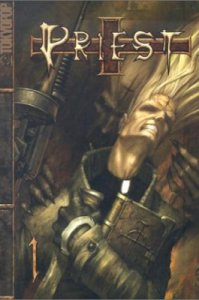Manga? Manwha?
Whether you go into Borders or Barnes and Noble these days, you’d see at least several bookcases devoted to manga and manwha. Given if this was few years ago, these publications might have taken up only a bookshelf or two. About 80-90% still consists of manga rather than manhwa. An article [link] wrote that even though you see the manhwa is getting more popular in the US as well as overseas, the domestic market itself isn’t doing very well. The imported Japanese manga still dominates the Korean readers market. However, this is balanced by the ballooning manhwa export to other countries all over the globe. Even with this rise in exporting, the article below mentions that “manhwa is still a subculture rather than a primary culture” because the Koreans are missing the massive anime market that the Japanese has over them.
* * *
The Koreans Are Coming: Manhwa in America
[http://www.publishersweekly.com/article/CA6403518.html]
 It shouldn’t be a surprise to American comics professionals that manhwa, or Korean comics, have become an increasingly important component of the competitive and ever-evolving manga market here in the United States. After Japan, Korea is the second-largest producer of original manga-style comics, and for major U.S.-based manga publishers such as Tokyopop and Dark Horse, or for smaller indie presses like Central Park Media and Drama Queen, Korean comics represent a fresh source for potentially lucrative properties. For Korean publishers such as Netcomics and Ice Kunion that have come to the U.S. to set up shop, the U.S. market promises an opportunity to reinvigorate an industry undermined by faltering domestic sales.
It shouldn’t be a surprise to American comics professionals that manhwa, or Korean comics, have become an increasingly important component of the competitive and ever-evolving manga market here in the United States. After Japan, Korea is the second-largest producer of original manga-style comics, and for major U.S.-based manga publishers such as Tokyopop and Dark Horse, or for smaller indie presses like Central Park Media and Drama Queen, Korean comics represent a fresh source for potentially lucrative properties. For Korean publishers such as Netcomics and Ice Kunion that have come to the U.S. to set up shop, the U.S. market promises an opportunity to reinvigorate an industry undermined by faltering domestic sales.
If your interests run toward shoujo (girls’) or shounen-ai (boys’ love), both of which are typically targeted toward young female audiences, chances are that you’ve probably already picked up a manhwa at some point, though you might not have realized it. Manhwa generally looks and reads very much like manga, with serialized stories covering such genres as kiddie adventures, teen rebellion and gothic romance. Although manhwa is read, like English-based comics, from left to right, little else distinguishes it in terms of form or content from its more popular Japanese counterpart. Even the word “manhwa” is just the Korean pronunciation of the same characters that the Japanese pronounce as “manga.”
However, some claim that important distinctions do exist. Tran Nguyen, the owner of Drama Queen, an all-woman-run indie publisher that has made manhwa a primary component of its girls’ comics lines, explains that she was attracted to manhwa because “On the whole, female lead characters in manhwa tend to be stronger, more modern women than their Japanese counterparts.” According to Ju-Youn Lee of Ice Kunion, one of two Korean publishers of manhwa based in the U.S., Korean manhwa tends to be more personal than “industrial,” or studio-system Japanese manga. “The greatest power of Korean manhwa is that it is closer to the creators,” says Lee.
Korean manhwa is also less explicit in content than Japanese manga, due in large part to stringent censorship laws that have been in place in Korea until only recently. Those laws have relaxed over the past few years, but as Jeremy Ross, editorial director for Tokyopop, explains, “Manhwa meets the kinds of standards that are expected in America. You don’t run into the kinds of problems that you might with Japanese manga that would have to be shrink-wrapped [because of explicit content] in the U.S.”
Still, it’s the similarities between manhwa and manga that have made manhwa increasingly important. As more and more Japanese publishers are bringing their own titles directly to the U.S., manhwa has become a key source of new materials for non-Japanese publishers. “We don’t have the open playing field that we did when Tokyopop was one of two or three people out there,” says Ross. He estimates that since Tokyopop first introduced manhwa to the U.S., the publisher has gone from publishing one or two titles to 85 licensed series, of which 45 to 50 have already been released in the U.S. Roughly 20% of Tokyopop’s list now consists of manhwa. CPM has also been publishing manhwa for years, and Dark Horse, released its first two manhwa titles this fall. The Korean Culture & Content Agency (KOCCA), a government-sponsored organization that seeks to promote Korean culture and content abroad, estimates that about 100 manhwa titles are currently being distributed in the U.S.
Manga vs. Manhwa
 U.S. publishers often find it easier to work with Korean publishers and artists. “I think Koreans think more globally than the Japanese,” Ross explains. “Just look at the culture—it’s much more focused on ‘how do we make products to sell to the world, how do we get things out to the world,’ rather than how do we create for the home audience.”
U.S. publishers often find it easier to work with Korean publishers and artists. “I think Koreans think more globally than the Japanese,” Ross explains. “Just look at the culture—it’s much more focused on ‘how do we make products to sell to the world, how do we get things out to the world,’ rather than how do we create for the home audience.”
This translates into differences in licensing of rights: Japanese publishers tend to restrict rights to very specific media, while Korean publishers automatically include online rights along with print rights. For Tokyopop, this has meant more of the cross-media licensing and property development deals that Tokyopop sees as essential to its idea of manga as a global phenomenon. Probably Tokyopop’s biggest success with this kind of licensing has been Priest, a Wild West–themed gothic horror written and drawn by Min-Woo Hyung, which was sold to Sam Raimi’s production company, Screen Gems, and is scheduled to be distributed by Sony Pictures—possibly the first time for an Asian-style graphic novel to be made into a Hollywood film. “Korea is not as closed a market as Japan,” says Ross. “In Japan, the artists are almost bonded with their publishers and editors for life. It’s very hard to try and get them to do anything different. We’re seeing a bit more experimentalism and flexibility in Korea.”
A huge incentive for this increased openness has been the steady decline of the print market for manhwa in Korea itself. One factor in this decline has been the ever-increasing popularity of illegally scanned manhwa available on the Internet. Another important fact has been the proliferation of reading libraries in Korea, called manhwabang or “comic rooms,” where visitors can rent a manga for a fraction of a book’s purchase price. According to some estimates, the rental market for manhwa in Korea is three times that of manhwa sales. According to Drama Queen’s Nguyen, “Artists have an incentive to do well in the U.S. They know... they can get more revenue for their work.”
Getting manhwa into the U.S. market via licensing deals hasn’t always been easy. One overambitious U.S.-based animation distribution company was forced to cut series and return licenses after initially licensing whole catalogues. As a result, Korean publishers have been eager to get into the lucrative U.S. market themselves.
 In October 2005, three of Korea’s largest manhwa publishers—Sigongsa, Seoul Cultural Publishers and Haksan—joined forces to create Ice Kunion. “Seeing how Viz was doing inspired us to start bringing Korean contents directly to the U.S. market,” says Lee of Ice Kunion. Ice Kunion currently has about 12 series out and plans to add a series each month, slowly increasing the numberof titles it will publish in 2007. Its bestselling titles include Angel Diary, written by the creators of one of Tokyopop’s most successful shounen-ai titles, Demon Diary. Its December releases includes Goong, a current bestseller in Korea that has already been turned into a TV show there. “We can provide the market with the newest titles,” says Lee.
In October 2005, three of Korea’s largest manhwa publishers—Sigongsa, Seoul Cultural Publishers and Haksan—joined forces to create Ice Kunion. “Seeing how Viz was doing inspired us to start bringing Korean contents directly to the U.S. market,” says Lee of Ice Kunion. Ice Kunion currently has about 12 series out and plans to add a series each month, slowly increasing the numberof titles it will publish in 2007. Its bestselling titles include Angel Diary, written by the creators of one of Tokyopop’s most successful shounen-ai titles, Demon Diary. Its December releases includes Goong, a current bestseller in Korea that has already been turned into a TV show there. “We can provide the market with the newest titles,” says Lee.
Netcomics, another Korean publisher of manhwa, came to the U.S. in January 2006 with a slightly different strategy. Korea is one of the most wired nations in the world, with a broadband penetration of 80%–85%. Despite the problems with illegal scanning, online comics publishing offers new opportunities. “Web comics and online manhwa services have been flourishing in Korea,” explains Heewoon Chung, president of Netcomics.
While most manga and manhwa companies have been experimenting with different ways of using the Internet to market their titles, Netcomics has gone a step further by trying to figure out how to transform those Internet hits into profits. In response to the problem of illegally scanned manhwa, Netcomics’ parent company, Ecomix Media, began paying artists a per-page rate for their work. Netcomics has in turn constructed an ingenious pay-per-view system for its English-reading audiences: customers have access to the first chapter of a book for free and are allowed to read the rest of the book online for a charge of 25¢ per chapter. The total cost of reading a book online is usually about $1. Since U.S. customers tend to want to buy the physical books as well, this service has been combined with the print publishing program, with the most popular online titles being released as books.
“Our online service allows us to serially publish brand-new titles,” Chung points out. “With this, we can accumulate the contents and at the same time build a fan base before the title is ready for publication.” According to Chung, user response has been very good. “Since our service is the only one of its kind available in the U.S., they don’t have anything else to compare it with.” By the end of 2006, Netcomics had 58 volumes of a total of 25 series, the most popular of which have been the shounen-ai titles Boy Princess, Let Dai and Not So Bad. Netcomics’ books are distributed by Ingram to bookstores and by Diamond and AAA Anime to the direct market.
Manhwa in the U.S. Market
For both Ice Kunion and Netcomics, selling manhwa to the U.S. market has produced as many problems as opportunities. Even differences in the relative sizes of Korea and the U.S. can have unexpected consequences. Ice Kunion’s Lee explains: “Compared to Korea, the U.S. is a really large country. This means that it takes a longer time to get books out there into bookstores, and that we have to move way ahead to keep up the publishing schedule.”
Even more difficult has been getting books onto the already crowded manga shelves of major bookstore chains. “In Korea, readers are well aware of not just what’s being published, but also about authors and titles,” Netcomics’ Chung says. “So when some new title receives good reviews, word gets spread fast, and retailers will stock the title in response.” Readers in the U.S. have less influence. “In the U.S., the market is driven by the national bookstores. And if your books are not on their shelves, readers will just not notice them. Even titles that receive great reviews can still be almost unknown to readers if they don’t get shelf space.”
Lack of name recognition has been a problem for U.S. and Korean publishers alike. That’s compounded by the fact that manhwa are rarely turned into animated films, often an important predictor of a title’s success. (Manhwa are often turned into live-action films or TV miniseries. While these may be extremely popular in Japan and Taiwan, they often do little to generate sales in the U.S.) “Kids aren’t rushing out to learn Korean and translating and putting up scanlations [online English translations of popular series] in Korean as much as they do Japanese,” points out Tokyopop’s Ross. “Manhwa is still a subculture rather than a primary culture.”
Even so, manhwa provides an important model for the future of U.S. manga. This is certainly true in terms of technology, where Koreans have been at the forefront of digital innovation with cellphones and other mobile content as well as with the Internet. “We’ve seen the Koreans as forging the way in terms of both a creative programming paradigm and also a technological paradigm for being able to do [the kind of things] we want to do,” says Tokyopop’s Ross.
It’s also true of basic manga culture, which continues to grow and influence new generations of artists, writers and readers. Netcomics’ Chung puts it this way: “What we’re seeing now in manga is [the influence of] Japanese culture,” says Chung. But he quickly notes, “U.S. manga culture will have its own identity when manga is no longer foreign to general book readers. Americanized manga titles will create their own culture that is both similar and different from other manga cultures.”

3 Comments:
I'm not surprised that manga and manhwa has become more popular in the US. I've never been a huge comic book fan in the past, but I've reallt enjoyed the two manhwas we read for this class. The artwork is beautiful and the stories are like watching a tv show. You can read them really quickly, or take your time and really look at each frame. I think they can appeal to a wide variety of readers, beyond the typical superhero base of traditional American comics.
I am in the same boat as Samantha, I was never a big comic book fan. I took Japanese Pop Culture last semester and was first introduced to a popular post-WWII comic called Barefoot Gen. After comparing it to Goong which we read this week, I think out of these two pieces Korean "manga/manhwa" is easier to understand.
The reason being is that it involves both actual dialogue and then on the inside of the frame you can see what the character is thinking at that current point in time. You cant do this with the medium of TV or in the Japanese Manga I experienced.
thanks you for sharing this, unlike the previous two comments I am actually a huge fan of manga and I will probably be doing my project on comics. I'd have to disagree with mikey on this one and say that barefoot gen is only one manga out of the thousands of different mangas that are out there now and each mangaka (artist) has their own unique way of telling their stories and I actually prefer the goong drama to the manwha.
Post a Comment
<< Home